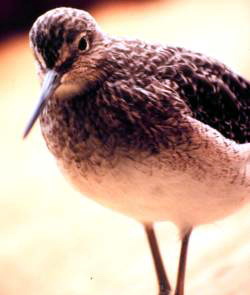|
| Query: short-billed dowitcher | Result: 3rd of 24 | |
Short-billed Dowitcher (Limnodromus griseus) - wiki
| Subject: | Short-billed Dowitcher (Limnodromus griseus) - wiki
| |

| Resolution: 250x295
File Size: 19342 Bytes
Date: 2007:08:27 01:06:42
Upload Date: 2007:08:27 01:09:36
|
Short-billed Dowitcher
From Wikipedia, the free encyclopedia
[Photo] Short-billed Dowitcher from NOAA. Title: Limnodromus griseus - a Short-billed Dowitcher. Location: Monterey Bay National Marine Sanctuary http://www.photolib.noaa.gov/sanctuary/sanc0812.htm
The Short-billed Dowitcher, Limnodromus griseus, is a medium-sized shorebird of the family Scolopacidae. The name of this bird can be somewhat misleading, as its bill is only short in comparison with the Long-billed Dowitcher. Its long, straight, dark bill is longer than the average shorebird.
The body of adults is dark brown on top and reddish underneath. The tail has a black and white barred pattern. The legs are a yellowish color. There are three subspecies with slight variations in appearance:
L. g. griseus has a white belly and barred flanks.
L. g. hendersoni has a reddish belly and spotted flanks.
L. g. caurinus has a white belly with heavily barred flanks and densely spotted breast.
None of these combines the reddish belly and barred flanks of the Long-billed Dowitcher. The winter plumage is largely grey.
Their breeding habitat includes bogs, tidal marshes, mudflats or forest clearings south of the tree line in northern North America. L. g. griseus breeds in northern Quebec; L. g. hendersoni breeds in north central Canada; L. g. caurinus breeds in southern Alaska.
These birds nest on the ground, usually near water. Their nests are shallow depressions in clumps of grass or moss, which are lined with fine grasses, twigs and leaves. They lay four, sometimes three, olive-buff to brown eggs. Incubation lasts for 21 days and is done by both sexes.
The downy juvenile birds leave the nest soon after hatching. Parental roles are not well known, but it is believed the female departs and leaves the male to tend the chicks, which find all their own food.
They migrate to the southern United States and as far south as Brazil. This bird is more likely to be seen near ocean coasts during migration than the Long-billed Dowitcher. This species occurs in western Europe only as an extremely rare vagrant.
These birds forage by probing in shallow water or on wet mud. They mainly eat insects, mollusks, crustaceans and marine worms, but also eat some plant material.
The call of this bird is more mellow than that of the Long-billed Dowitcher, and is useful in identification, particularly of the difficult adult plumages.
http://en.wikipedia.org/wiki/Short-billed_Dowitcher
| The text in this page is based on the copyrighted Wikipedia article shown in above URL. It is used under the GNU Free Documentation License. You may redistribute it, verbatim or modified, providing that you comply with the terms of the GFDL. |
|
Comments |
|---|
| | name |
|
| Good day!, |
| | name |
|
| Hi!, |
| | name |
|
| Good day!, |
| | name |
|
| Good day!, |
| | name |
|
| Hello!, |
| | name |
|
| Good day!, |
| | name |
|
| Hi!, |
| | name |
|
| Hi!, |
| | name |
|
| Hi!, |
| | name |
|
| Hi!, |
| | name |
|
| Hi!, |
 |

|

|
short-billed dowitcher
3/24 |

|

|
^o^
Animal Pictures Archive for smart phones
^o^
|
|
|

